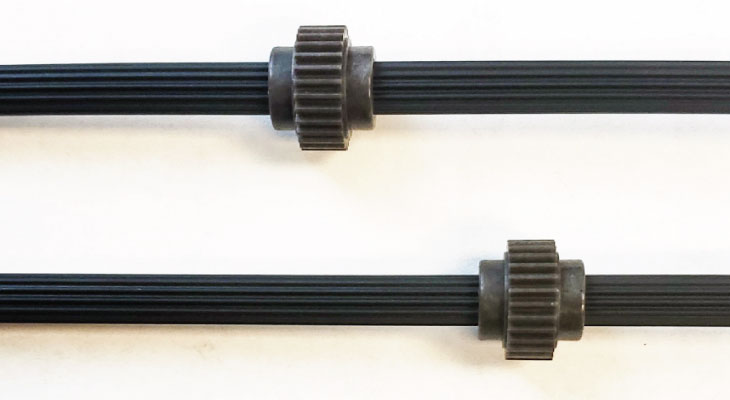Precision Torque Splines - for a variety of Applications

What are torque splines?
Torque splines are highly customizable multi-functional linear motion assemblies that are used to provide two axes of motion. Teeth on a drive shaft match with corresponding grooves on a mating piece that transfer torque while maintaining angular correspondence. Precision torque splines are used both as a guide rail and transmit torque for convenient Z-axis, theta, or X-Z and Y-Z axes of motion. HERE is a video on our Torque Splines showing the different configurations. Typical applications include lab automation, packaging, business systems, food processing, textile, and semi-conductor. Lab Automation can be a simple pick and place application or pipetting and dispensing, or carousel multi-sampling systems. Packaging, food process, and textile applications often have a torque shaft that may drive a conveyor or belt with an attached sprocket while also having the spline shaft capable of width adjustments and lane changers for product handling.
Torque spline shafts are often used to replace D-shape or hex-shaped shafts. The contact surface of the spline, based on its geometry, helps reduce clearances between the bushing and the shaft to provide a better fit. For other precise applications, an anti-backlash (rotational) bushing is offered for zero clearance. In lighter-duty z-axis applications, spline shafts can run parallel to a lead screw assembly and be the anti-rotation shaft for creating linear motion -- possibly eliminating the need for a second guide shaft.
Torque spline shafts are manufactured using 300-series stainless steel, and the accompanying bushings are made from a high-strength polymer nut with tensile strength greater than 9,500 psi (65.5 MPa) and yield strength greater than 12,000 psi (82.7 MPa). The bushing material has PTFE for added lubricity, providing a coefficient of friction of .15 (non-coated). Low friction PTFE coatings can reduce the sliding friction to .08, significantly increasing bushing life up to 10 times. The use of low friction coatings eliminates the need for the addition of grease, which is necessary to avoid in clean environments required in medical, semi-conductor, and food-processing applications.
Shaft diameters provide different load carrying capacity and torque capacity based on side-loading, rail length, and orientation. For higher load carrying capacity, two bushings can be used to share the load. For cantilevered applications, these bushings can be spaced apart to increase the wheelbase and load capacity. The spacing should be no more than a 2:1 ratio (if the overhang is 200mm, the bushings should be spaced at 100mm or further apart).
Torque splines are highly customizable. Pullies can be added on the outside diameter to drive a belt on one axis. When the spline shaft rotates, it provides guidance on a second axis of linear travel. Another customization example; two bushings can be used on the same shaft; one can have the internal spline to be the drive bushing, and the other bored to the spline's original diameter to function as a passive bushing for guidance only. Also, the spline shaft may be used to move paper registration guides in business machines or a fence guide in a packaging machine application. In both these cases, the torque spline can be rotated to easily remove the gate from the flow path and allow the product to pass through. Standard thread mount, plain/cylinder mount or flange mount options are available for the bushings to adapt to various mating components. Custom flanges can be designed to accommodate space constraints or the elimination of other parts.
Download our Miniature Precision Torque Spline Catalog here.
The torque splines are precision shafts that offer reliable consistency and repeatability. Specifications such as straightness and twist are controlled tightly and monitored closely during the manufacturing process. As you learn more about the torque splines' uses and versatility, it becomes clear that this product is underrated for its capabilities to provide performance and functionality.
Ready to customize a precision torque spline for your linear motion project?


